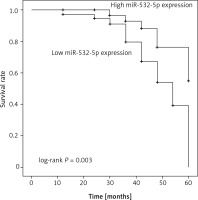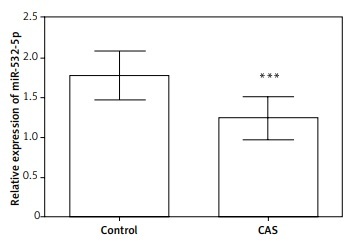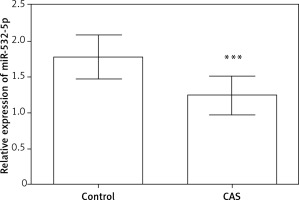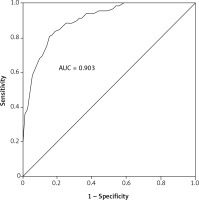Introduction
Carotid artery stenosis (CAS) is the condition characterised by the narrowing of one or both of the carotid arteries, accompanied by the formation of plaque within the carotid artery [1]. As a result of an unhealthy lifestyle and the high incidence of dyslipidaemia, diabetes, and hypertension, the prevalence of CAS is increasing [2]. Recently the association of CAS with the occurrence of cerebral ischaemic events (CIEs) has attracted more and more attention [3]. Carotid artery stenosis plays a crucial role in the occurrence of stroke, which is considered to be a debilitating disease with high morbidity [4]. Carotid artery stenosis is a progressive disease, and patients with asymptomatic CAS are always misdiagnosed or untreated [5]. Severely, ischaemic stroke (IS) is always the first clinical manifestation of CAS, and it is often fatal [6]. Therefore, the early diagnosis and treatment of patients with asymptomatic CAS is crucial.
In recent years, circulating microRNAs (miRNAs) have been widely identified as promising and novel biomarkers for the diagnosis of human diseases [7, 8]. MiRNAs are evolutionarily conserved, single-stranded RNAs participating in various physiological and pathological processes through regulation of the target gene expression [9]. MiRNAs play a regulatory role in the function of cardiomyocytes, endothelial cells (ECs), vascular smooth muscle cells (VSMCs), and platelets, which is involved in the initiation and progress of atherosclerosis (AS), and AS is considered to be the main cause of CAS [10–12]. Previous studies demonstrated that miR-532-5p was downregulated in many atherogenic processes, and acts as an important participant in cardiovascular and cerebrovascular diseases [13, 14]. As Li et al. reported, miR-532-5p serves as a potential diagnostic biomarker for ischaemic stroke (IS) [14]. Considering the crucial role of miR-532-5p in AS, the significance of miR-532-5p in CAS has attracted our attention.
To better understand the role of miR-532-5p in CAS, the present study sought to detect the expression profile of miR-532-5p in CAS clinical samples. MiR-532-5p was identified to be downregulated in asymptomatic CAS patients, and to have some ability for the early diagnosis of CAS. Furthermore, the predictive value of miR-532-5p for the occurrence of CIE was also investigated.
Material and methods
Study population and sample collection
All participants involved in the study initially underwent carotid artery Doppler ultrasonography (CDUS) followed by computed tomography angiography (CTA). Carotid artery stenosis was diagnosed according to the ultrasound criteria, an asymptomatic status was confirmed by a review of the patient’s history and a physical examination [15, 16]. A total of 71 asymptomatic CAS patients from Binzhou Medical University Hospital were recruited in the current study between 2012 and 2014. The inclusion criteria were as follows: 1) suffered from stroke or transient ischaemic attack; 2) received carotid revascularisation; and 3) had a history of myocardial infarction, cardiomyopathy, severe pulmonary disease, and arrhythmia. There were another 70 healthy volunteers included in this study, who underwent routine physical examination in the hospital and were proven to have normal Doppler ultrasound or evidence of carotid stenosis < 20%. Individuals who had inflammatory diseases, cardiovascular diseases (CVDs), diabetes, hypertension, hyperlipidaemia, autoimmune disease, or cancer were excluded from the control group. Blood samples were collected from each participant, then the serum was isolated by centrifugation and stored at –80°C for further analysis. The results of physical examinations, including blood pressure, plasma glucose, plasma lipid, and degree of carotid stenosis, were recorded. Hypertension was defined as a systolic blood pressure of ≥ 140 mm Hg or a diastolic blood pressure of ≥ 90 mm Hg or use of antihypertensive drugs. Diabetes mellitus was defined as a fasting blood glucose level of ≥ 126 mg/dl or current use of oral antidiabetic drugs or insulin. Hyperlipidaemia was defined as a total cholesterol level of ≥ 200 mg/dl.
The protocols of this study were approved by the Ethics Committee of Binzhou Medical University Hospital, and each participant signed an informed consent form.
Follow-up survey
All patients were followed up for 5 years. The primary endpoint was the occurrence of an ipsilateral cerebral ischaemic event, including stroke, transient ischaemic attack (TIA), or sudden death.
RNA extraction and quantitative real-time PCR (qRT-PCR)
Total serum RNA was extracted using TRIzol reagent (Invitrogen, Carlsbad, CA, USA) in accordance with the manufacturer’s instructions. After the determination of the RNA purity and concentration, the collected RNA was reverse transcribed into cDNA by a PrimeScript RT Reagent Kit (Takara, Tokyo, Japan). Then the qPCR was performed using a SYBR green I Master Mix Kit (Invitrogen, Carlsbad, CA, USA) and the 7300 real-time PCR System (Applied Biosystems, USA). The following thermocycling conditions were used for the PCR: initial denaturation at 95°C for 5 min; 30 cycles of 95°C for 30 s, 60°C for 30 s and 72°C for 20 s; and a final extension at 72°C for 10 min. The relative miRNA expression level was calculated using the 2–ΔΔCt method and normalised to U6. The primers used were as follows: miR-532-5p forward, 5’-GCCCATGCCTTGAGTGTAG-3’ and reverse, 5’-GTGCGTGTCGTGGAGTCG-3’; and U6 forward, 5’-CTCGCTTCGGCAGCACA-3’ and reverse, 5’-AACGCTTCACGAATTTGCGT-3’.
Statistical analysis
All the data were calculated using SPSS 21.0 software (SPSS Inc., Chicago, IL) and GraphPad Prism 7.0 software (GraphPad Software, Inc., USA). Differences between groups were assessed using Student’s t-test or one-way ANOVA. Receiver operating characteristic (ROC) analysis was used to evaluate the diagnostic value of miR-532-5p in asymptomatic CAS patients, and the area under the curve (AUC) was calculated. The predictive value of miR-532-5p for the occurrence of CIE was evaluated by using Kaplan-Meier method and Cox regression analysis. A p-value of less than 0.05 indicated statistical significance.
Results
Demographic characteristics of the study population
The demographic and clinical characteristics of the control and CAS patient groups were compared. As shown in Table I, there was no significant difference for age, gender, and body mass index (BMI) between the control and CAS patient groups (all p > 0.05).
Expression changes of miR-532-5p in the serum of carotid artery stenosis patients
According to qRT-PCR, serum expression of miR-532-5p was detected to be significantly decreased in CAS patients compared with healthy controls (Figure 1, p < 0.001), indicating that miR-532-5p might play an important role in the pathogenesis of CAS.
Correlation of miR-532-5p expression with clinicopathological parameters of carotid artery stenosis patients
According to the mean value of miR-532-5p expression in CAS patients, all patients were divided into two groups: a low-expression group (n = 38) and a high-expression group (n = 33). MiR-532-5p expression showed a significant association with diabetes and degree of carotid stenosis (Table II, all p < 0.05). By contrast, there was no significant association between miR-532-5p expression and age, gender, BMI, dyslipidaemia, and hypertension (all p > 0.05).
Table II
Association of miR-532-5p with clinical parameters in asymptomatic carotid artery stenosis (CAS) patients
| Parameters | Total No. N = 71 | miR-532-5p expression | P-values | |
|---|---|---|---|---|
| Low (n = 38) | High (n = 33) | |||
| Age: | ||||
| ≤ 60 | 34 | 17 | 17 | 0.569 |
| > 60 | 37 | 21 | 16 | |
| Gender: | ||||
| Male | 41 | 23 | 18 | 0.611 |
| Female | 30 | 15 | 15 | |
| Body mass index: | ||||
| < 25 | 34 | 16 | 18 | 0.295 |
| ≥ 25 | 37 | 22 | 15 | |
| Dyslipidaemia: | ||||
| Absence | 32 | 14 | 18 | 0.135 |
| Presence | 39 | 24 | 15 | |
| Diabetes: | ||||
| Absence | 33 | 13 | 20 | 0.026* |
| Presence | 38 | 25 | 13 | |
| Hypertension: | ||||
| Absence | 38 | 18 | 20 | 0.265 |
| Presence | 33 | 20 | 13 | |
| Degree of carotid stenosis: | ||||
| 50–69% | 33 | 12 | 21 | 0.007** |
| 70–99% | 38 | 26 | 12 | |
Diagnostic value of miR-532-5p in patients with carotid artery stenosis
Considering the dysregulation of miR-532-5p in the serum of CAS patients, the present study further investigated the clinical significance of miR-532-5p in the diagnosis of asymptomatic CAS. As shown in Figure 2, the ROC curve with an AUC of 0.903, indicated high diagnostic accuracy of serum miR-532-5p expression in asymptomatic CAS patients. At the cut-off of 1.455, the sensitivity was 81.7% and the specificity was 84.3%.
Prognostic value of miR-532-5p expression for the occurrence of CIE in asymptomatic carotid artery stenosis patients
Seventy-one asymptomatic CAS patients were followed up for 5 years, and during the follow-up, neither death nor contralateral ischaemic events occurred. It was recorded that among 71 asymptomatic CAS patients, 27 cases suffered from CIE, including 17 TIAs and 10 strokes. As Kaplan-Meier analysis results suggested, more CIE events were observed in cases with low miR-532-5p expression (log-rank p = 0.003, Figure 3). Additionally, the influence of the clinical parameters on the occurrence of CIE was further detected by using multivariate Cox analysis. It was observed that low miR-532-5p (HR = 3.388, 95% CI: 1.155–9.940, p = 0.026) and a high degree of carotid stenosis (HR = 4.200, 95% CI: 1.145–15.412, p = 0.030) were independent factors for the occurrence of CIE in asymptomatic CAS patients (Table III).
Figure 3
Prognostic value of miR-532-5p expression for the occurrence of cerebral ischaemic events (CIE) in asymptomatic carotid artery stenosis patients. Kaplan-Meier analysis results indicated that more CIE events were observed in cases with low miR-532-5p expression (log-rank p = 0.003)

Table III
Multivariate Cox regression analysis for miR-532-5p in asymptomatic carotid artery stenosis (CAS) patients
| Variables | Multivariate analysis | ||
|---|---|---|---|
| HR | 95% CI | P-value | |
| MiR-532-5p | 3.388 | 1.155–9.940 | 0.026* |
| Age | 1.960 | 0.788–4.874 | 0.147 |
| Gender | 0.558 | 0.218–1.424 | 0.222 |
| Body mass index | 1.376 | 0.525–3.607 | 0.516 |
| Dyslipidaemia | 2.221 | 0.856–5.766 | 0.101 |
| Diabetes | 1.740 | 0.687–4.410 | 0.243 |
| Hypertension | 2.483 | 0.903–6.833 | 0.078 |
| Degree of carotid stenosis | 4.200 | 1.145–15.412 | 0.030* |
Discussion
The present study recruited a cohort of asymptomatic CAS patients, and serum expression of miR-532-5p was identified to be significantly decreased in asymptomatic CAS patients, suggesting its potential role in the occurrence of CAS in the early stage. According to the ROC curve, high diagnostic accuracy of serum miR-532-5p expression in asymptomatic CAS patients was detected. Additionally, the present results also provided evidence for the predictive significance of serum miR-532-5p for the risk of future CIEs in asymptomatic CAS patients.
Carotid artery stenosis is triggered by the formation of plaque within the carotid artery, which supplies blood to the brain. Such atherosclerotic pathology can proceed silently from the simple thickening of the carotid intima-media to the symptomatic stenosis [17]. In later stages, plaques can mature and often become unstable, rupture, and lead to acute ischaemic events. It is reported that CAS events cause more deaths in developed countries than cancer and injuries, and with advances in health care and rising life expectancy, the prevalence of CAS in developing countries is still increasing [18–20]. Understanding and maximising primary prevention strategies for asymptomatic CAS is therefore critical. Recent concerns focus on the early diagnosis and treatment of patients with asymptomatic CAS. And identifying patients at higher risk of developing future TIEs can be conducive to targeting intensive therapy more appropriately [21].
In recent years, a large amount of miRNAs have been determined to be aberrantly expressed in human carotid plaques, such as miR-125a, miR-133a, and miR-221 [22]. These deregulated miRNAs have been highlighted for their clinical significance in diagnosis and prognosis and have attracted increasing attention due to their therapeutic potential in human diseases [23–25]. For example, in coronary artery disease (CAD) patients, circulating miR-29a-3p is detected to be significantly increased, and has relative ability for the early diagnosis of CAD [26]. In the present study, serum expression of miR-532-5p was identified to be significantly decreased in asymptomatic CAS patients, suggesting the potential role of miR-532-5p for CAS in the early stage.
MiR-532-5p has been reported to be dysregulated in a variety of conditions, and its clinical value in diagnosis and prognosis attracts a great deal of scholarly attention. For example, miR-532-5p is identified to be poorly expressed in IS patients by using miRNA microarray analysis, and serum miR-532-5p may serve as a potential diagnostic biomarker for IS [14]. Considering the dysregulation of miR-532-5p in the serum of asymptomatic CAS patients, we further explored its diagnostic value for asymptomatic CAS. The present study provided evidence for high diagnostic accuracy of serum miR-532-5p expression in asymptomatic CAS patients by using the ROC curve. Additionally, analysis results of the clinical data revealed that miR-532-5p expression also showed significant association with degree of carotid stenosis. The degree of carotid stenosis is known to be an important predictor of future CIEs and cerebrovascular accidents (CVAs) in both symptomatic and asymptomatic patients [27]. The current study results indicated that more CIE events were observed in cases with low miR-532-5p expression, and serum miR-532-5p could identify cases at higher risk of developing future CIEs in asymptomatic CAS patients. Furthermore, low miR-532-5p was also determined to be an independent factor for the occurrence of CIEs in asymptomatic CAS patients through multivariate Cox analysis. The current study provides evidence for the potential diagnostic value of serum miR-532-5p for asymptomatic CAS and its predictive significance for the risk of future CIEs for asymptomatic CAS patients. However, further studies in larger series of patients are necessary to confirm our findings.
Additionally, a significant association of miR-532-5p level with diabetes was observed. Consistently, in a study of circulating miRNA profile in type 2 diabetes (T2D), a marked decrease of miR-532-5p was detected in T2D patients [28]. And a potential relevance of miR-532-5p in insulin sensitivity was determined by Jones et al. [29]. Furthermore, aberrant expression of miR-532-5p was also detected to be associated with the fasting blood glucose trajectories of T2D patients [30]. Studies have shown a high cardiovascular risk among patients with diabetes [31]. The present study suggested that more diabetes cases were observed in patients with low miR-532-5p expression. There is strong evidence that diabetes mellitus increases the risk of AS, and it also promotes the pervasiveness of AS, infiltration of inflammatory cells, and plaque necrosis [32, 33]. The possible mechanism of miR-532-5p in the occurrence and development of CAS underlying the involvement of diabetes requires further study. Another study by Cheng et al. reported that in lipopolysaccharide (LPS)-treated macrophage cells, miR-532-5p is determined to be poorly expressed, suggesting its involvement in the macrophage inflammatory response, which plays an important role in the occurrence and development of AS [34, 35], which might is a potential mechanism of the involvement of miR-532-5p in the development of CAS and future CIE events. However, our study population was relatively small, and other studies in larger series of patients would be necessary to confirm our findings.
In conclusion, our study suggests the potential clinical value of miR-532-5p for the early diagnosis of asymptomatic CAS patients. MiR-532-5p might play a predictive value for the occurrence of future CIE in asymptomatic CAS patients. However, further studies in larger series of patients are necessary to confirm our findings.





